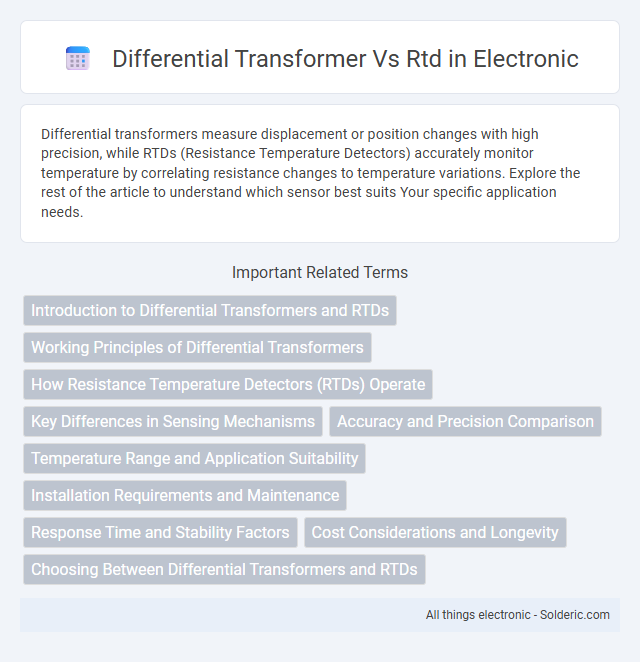Differential transformers measure displacement or position changes with high precision, while RTDs (Resistance Temperature Detectors) accurately monitor temperature by correlating resistance changes to temperature variations. Explore the rest of the article to understand which sensor best suits Your specific application needs.
Comparison Table
| Feature | Differential Transformer | RTD (Resistance Temperature Detector) |
|---|---|---|
| Measurement Principle | Inductive displacement sensing via differential transformer | Temperature-dependent electrical resistance |
| Primary Use | Position, displacement, or proximity measurement | Precise temperature measurement |
| Accuracy | Micrometer-level displacement accuracy | High temperature accuracy, typically +-0.1degC |
| Output Signal | Voltage proportional to displacement | Resistance value corresponding to temperature |
| Operating Range | Millimeters to centimeters displacement range | Temperature range: -200degC to +850degC (depending on type) |
| Environmental Sensitivity | Immune to temperature variations, sensitive to magnetic fields | Sensitive to temperature drift and self-heating effects |
| Applications | Industrial automation, material testing, robotics | Industrial process control, HVAC, laboratory measurements |
| Typical Materials | Coil-based sensor with ferromagnetic core | Platinum wire or film elements |
Introduction to Differential Transformers and RTDs
Differential transformers, commonly known as LVDTs (Linear Variable Differential Transformers), are precise sensors used for measuring linear displacement by converting mechanical movement into an electrical signal. Resistance Temperature Detectors (RTDs) measure temperature by correlating the resistance of a metal, typically platinum, with temperature changes. Both devices offer high accuracy and reliability, but differential transformers excel in displacement measurement while RTDs are specialized for temperature sensing.
Working Principles of Differential Transformers
Differential transformers operate on the principle of electromagnetic induction, where the primary coil generates a magnetic field that induces voltages in two secondary coils wound in opposite directions, allowing displacement measurements with high precision. Unlike RTDs that measure temperature through resistance changes in a metal sensor, differential transformers rely on changes in inductive coupling caused by a movable core, making them ideal for position and displacement sensing. Your choice between a differential transformer and an RTD depends on whether precise positional feedback or accurate temperature measurement is required.
How Resistance Temperature Detectors (RTDs) Operate
Resistance Temperature Detectors (RTDs) operate by measuring temperature through the precise change in electrical resistance of a metal element, commonly platinum, as it varies predictably with temperature. Unlike differential transformers which utilize inductive coupling to detect position changes, RTDs rely on the linear relationship between temperature and resistance, enabling highly accurate and stable temperature readings. The RTD element is typically constructed in a thin wire or film form, and its resistance is measured using a Wheatstone bridge or similar circuit for temperature determination.
Key Differences in Sensing Mechanisms
Differential transformers utilize electromagnetic induction to measure displacement or position changes by detecting variations in coil inductance, whereas RTDs (Resistance Temperature Detectors) rely on precise resistance changes in materials such as platinum to measure temperature. Differential transformers provide contactless sensing with high sensitivity to mechanical movement, while RTDs offer accurate and stable temperature measurement through direct interaction with thermal conditions. The fundamental difference lies in differential transformers measuring physical displacement via inductance changes, while RTDs sense temperature through material resistance variation.
Accuracy and Precision Comparison
Differential transformers typically offer higher precision and excellent linearity, making them ideal for applications requiring fine displacement measurements, while RTDs provide high accuracy in temperature sensing through stable resistance changes. Your choice depends on whether precise mechanical position detection (differential transformer) or accurate thermal measurement (RTD) is critical for the system. In terms of measurement reliability, differential transformers excel in repeatability, whereas RTDs maintain consistent accuracy over a wide temperature range.
Temperature Range and Application Suitability
Differential transformers provide high accuracy and sensitivity in temperature measurements typically within the range of -55degC to 150degC, making them ideal for precise industrial and scientific applications. Resistance Temperature Detectors (RTDs) operate effectively over a broader temperature spectrum, from -200degC to 850degC, offering robust performance for high-temperature environments such as power plants and manufacturing processes. The choice between differential transformers and RTDs depends on the required temperature range and measurement precision needed for specific applications.
Installation Requirements and Maintenance
Differential transformers require precise alignment and stable mounting to ensure accurate displacement measurements, with periodic calibration crucial to maintain signal integrity. RTDs demand proper wiring and insulation from environmental factors, needing regular resistance checks and calibration to guarantee temperature measurement accuracy. Both sensors benefit from clean, secure installations but differ in their specific maintenance routines due to their measurement principles.
Response Time and Stability Factors
Differential transformers offer faster response times compared to RTDs due to their electromagnetic sensing principle, which allows rapid detection of temperature changes. RTDs, based on resistance change in metals, exhibit slower response times influenced by sensor material and sheath design. Stability factors for differential transformers include electromagnetic interference and mechanical vibrations, whereas RTDs benefit from high stability but can drift over time due to material aging and contamination.
Cost Considerations and Longevity
Differential transformers generally have a higher initial cost compared to RTDs due to their complex construction and precision components. RTDs offer a more cost-effective solution with good accuracy and are known for their long lifespan, often exceeding 10 years when properly maintained. Your choice may depend on balancing budget constraints with the desired durability and measurement stability in your application.
Choosing Between Differential Transformers and RTDs
Choosing between differential transformers and RTDs depends on the specific application requirements involving precision and environmental conditions. Differential transformers, such as LVDTs, provide highly accurate, non-contact displacement measurements and are ideal for dynamic and high-frequency measurements, while RTDs excel in precise temperature sensing with excellent stability and repeatability. Consider factors such as measurement type, required accuracy, operating temperature range, and susceptibility to electrical noise when selecting between these sensors.
differential transformer vs rtd Infographic

 solderic.com
solderic.com